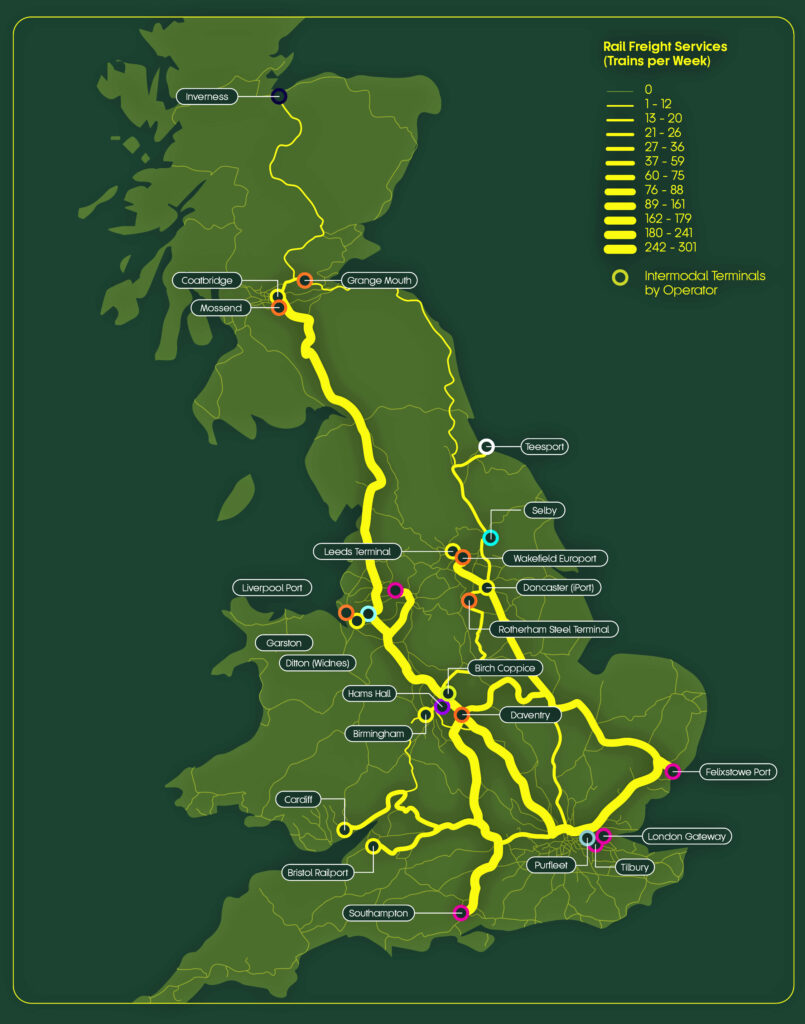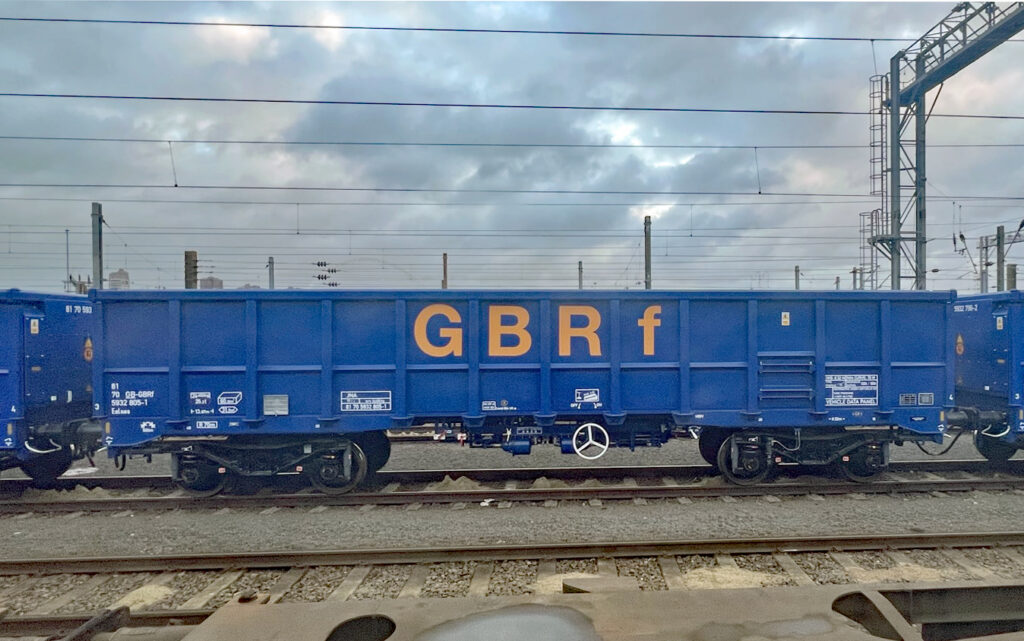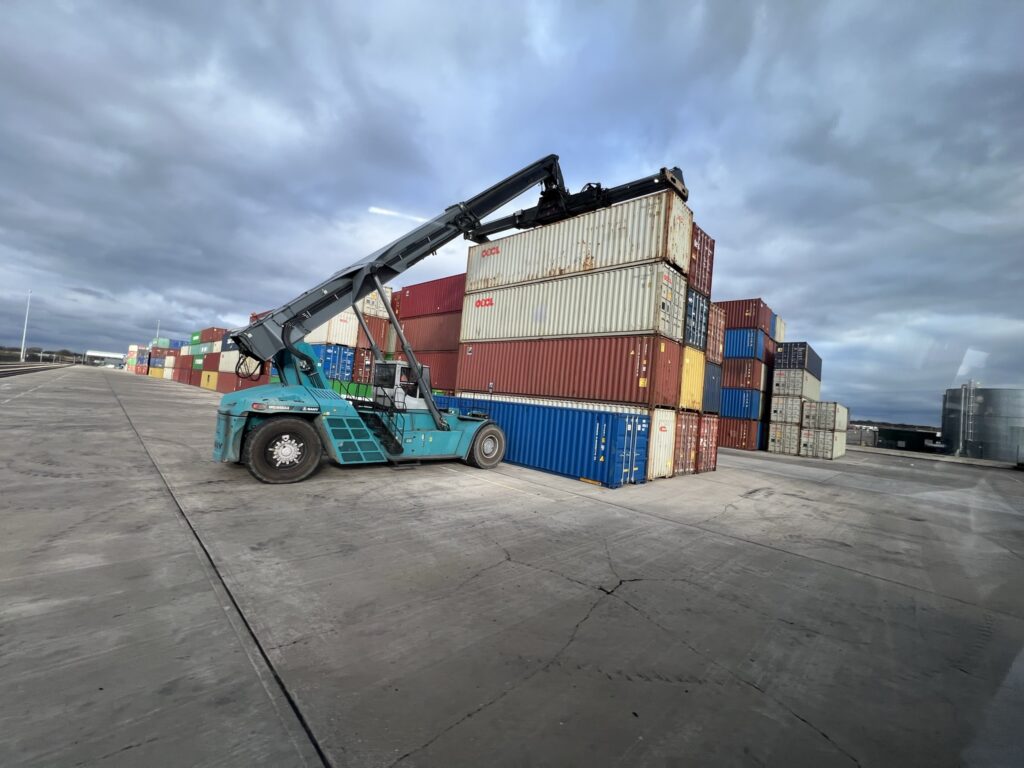Speaking at Unlocking Innovation – Rail Freight, an event held by the Railway Industry Association (RIA) in Doncaster on 22 February, Maggie Simpson, chief executive of the Rail Freight Group stressed the need for growing rail freight which benefits the UK economy by £2.5 billion each year.
At the same event Richard Moody, programme director (freight reform) for the Great British Railways Transition Team (GBRTT), echoed this call and noted that rail freight was a huge private sector success story. Both speakers stressed the need for innovation to improve productivity and sustainability. Richard stressed that GBR would ensure that all research, development, and innovation activity was joined up.
The need to grow rail freight was further highlighted by a recently published Rail Partners report which called for the trebling of rail freight by 2050 as this would remove 20 million HGV journeys each year. In December 2022, GBRTT published its Market Development Plan explaining how its Strategic Freight Unit (SFU) will grow rail freight.
Neither of these documents focused on innovation, although it was clear from RIA’s Unlocking Innovation event that this is essential if the required rail freight growth is to be achieved. The GBRTT report explains how its Strategic Freight Unit (SFU) will grow rail freight by:
- Setting an ambitious target.
- A stable access regime. As GBR will get passenger service revenue, this needs the ORR to ensure that GBR awards freight paths in a non-discriminatory manner.
- Make best use of existing capacity by running longer, heavier freight trains.
- Targeted infrastructure investments.
- Expanding incentives to use rail freight including increasing the Mode Shift Revenue Support scheme and introducing to England the Rail Freight Facilities Grant scheme that currently applies in Scotland and Wales.
Electrification infill
As well as decarbonising freight, electric traction is the only way to run the longer, heavier freight trains that are essential for rail freight growth as electric locomotives have typically twice the power of a diesel locomotive (electric class 92 – 5MW, diesel class 66 – 2.2 MW). Currently, only 10% of British freight trains are electrically hauled despite two-thirds of the core 3,200km rail freight network already being electrified.
Hence both Rail Partners and the Chartered Institute of Logistics and Transport (CILT) consider that electrification infill is essential to significantly increase freight growth. The CILT has produced a map showing how 1,200 route kilometres of electrification would enable about 95% of freight trains to be electrically hauled. This would produce substantial benefits in addition to decarbonising both rail and road freight by modal shift.

The most urgent CILT proposals are the following key infill sections totalling 90km which currently prevent freight trains being electrically hauled over long distances. These are six ‘no regret’ schemes to electrify short lines to enable electric trains to run to the ports of London Gateway, Felixstowe, and Liverpool’s Seaforth as well as the Leeds and Birmingham Freightliner terminals.
The Rail Partners report estimates that, on the basis of carbon and air pollution savings alone, electrification of the London Gateway and Felixstowe will have 30-year cost benefit ratios of respectively 4.75:1 and 4.24:1.
The CILT then prioritises its proposals as: i) Felixstowe to Nuneaton; ii) Peterborough to Doncaster via Lincoln; iii) Southampton to Bletchley via East West Rail; iv) routes from quarries in the Mendips and Peak District; and v) routes serving the steel industry including Port Talbot, Middlesbrough and Immingham.
Network enhancements
As well as electrification infill schemes, the Rail Partners report identifies the enhancements needed if rail freight is to be trebled by 2050. The report notes the importance of the already committed Transpennine Route Upgrade and HS2, although an alternative to the Golbourne Link is essential if HS2 is to maximise freight benefits.
The report also highlights the need for gauge clearance including Didcot to Cardiff and Wembley to the Channel Tunnel, as well as stressing the strategic importance of the £450 million Ely Area Capacity Enhancement scheme which is currently “indefinitely paused”.
The need for enhanced freight routes was also stressed by Lucy Hudson at the Unlocking Innovation event. Lucy is principal policy officer, freight and logistics, for Transport for the North (TfN) which recently published its Freight and Logistics strategy. This stressed the importance of getting rail freight across the Pennines to connect the port of Liverpool with the ports of Hull, Grimsby, and Immingham. However, the lack of a W12 gauge cleared route across the Pennines is a particular constraint in this respect.
Lucy also described how TfN was working closely with other sub-national transport bodies to provide joint responses to government, for example on the need for the Ely capacity improvement.
Automatic coupling
Innovation is also needed to grow rail freight, as was clear at the Unlocking Innovation event. Today’s freight wagons have no power or data lines and use the twin-pipe air brake that was introduced on Freightliner trains in 1965. Coupling requires the manual connection of screw couplings and air hoses. Train despatch requires an examiner to confirm that all hand brakes are released and undertake a brake test to confirm the application and release of brakes.
For these reasons, the European rail freight sector is planning to fully deploy Digital Automatic Coupling (DAC) by 2030. This would provide train integrity as required by ERTMS level 3 as well as providing wagons with power and data lines to provide the benefits shown in the table.

RSSB report T1264 estimates that fitting DAC and the equipment to provide all the enabled benefits to all the required 13,617 freight wagons by 2030 would cost £600 million. It concludes that autocoupling offers little benefit as ‘block trains’ are the norm in the UK and that whilst DAC offers derailment mitigation, its benefits do not cover the fitment costs. The report notes that there may be simpler ways of achieving these benefits.
This was the view of Knorr Bremse (KB)’s digital services business development manager, John May who felt there were opportunities for self-powered solutions such as KB’s derailment detection system which is soon to be introduced in the UK. This consists of an emergency brake valve that operates when an indicator registers significant increases in vertical acceleration. He advised that KB was also developing a wagon wheel slide protection system which requires wagon power generation. This also offers the opportunity to monitor such things as distribution and parking brake status, and get data off the wagon so that operators can be made aware of potential problems before they get worse.
Remote condition monitoring
Instrumentel is part of the Unipart group specialising in extracting data from extreme environments. As an example, its sales director, Sam Bussey explained how the company used inductively coupled miniature electronic operating at very high temperatures to take a million samples per second to perfect the design of a Formula one engine.
In the rail sector, Instrumentel is working with Porterbrook and Cross Country to monitor engine and power trains and is collecting data from 600 vehicles every second over routes totalling 10,000km. It has used machine learning to develop a system to predict failures and reduce maintenance by eliminating tests as components are monitored in real time. This also predicts and prevents in-service failures.
The company’s Paradigm insight web portal enables operators to understand their asset performance with easily accessible dashboards that notify any faults. This offers actionable data from assets operating in difficult-to-access environments. Freight wagons without electrical power are clearly such an environment.
Self-powered wagons
The radical solution of self-powered wagons was presented by Simon Evans, Wabtec’s group innovations director, and Tim Danvers, Atkins’ business development director.
The proposition is the fitment of a traction motor and battery to each wagon to recover braking energy so that when a train with 32 wagons accelerates, its train’s peak power could be 10MW for 10 minutes, compared with 2.4MW from its diesel locomotive. This would also offer on-board wagon power enabled benefits such as wheel slide prevention and electro pneumatic braking. There would be less performance benefits for more powerful electric freight trains which have regenerative braking, albeit only for the locomotive. However, this would offer last mile operation.
It is anticipated that a prototype self-powered will be trialled by the end of 2024.The motor for this wagon would be similar to that Wabtec is developing for fitment to passenger diesel multiple units for which they were awarded a £59,450 grant by Innovate UK in November.

Doing things differently
Innovation does not necessarily require new technologies. New ideas and processes also offer significant benefits. In her presentation, DB Cargo’s chief transformation and digitalisation officer, Marie Hill, advised that we need to get people to think about things differently, offer suggestions, and challenge the way we do things. She noted that “we never have all the answers, and we are never the first to face the problem.” Hence it is important to learn from others, especially those who are world-class for a particular process.
GB RailFreight’s business development manager, Tim Hartley, also stressed the need to focus on people. As an example, he explained the company’s social value pilot programme that mentors 15-year-olds in deprived areas to attract new and diverse talent. He also described how the provision of body worn cameras had proved to be a worthwhile initiative. Following incidents these had proved that examiners were doing their job properly.
Tim also explained how the company’s new Peterborough depot will examine wagons using smart sensors and how visual indications had been provided to show handbrakes were released. He noted that the company’s biggest recent investment was in 30 x Class 99 Co-Co bi-mode locomotives which will be introduced in 2025.
From RSSB, Robert Staunton, research and innovation account manager and Aaron Barrett, lead analyst explained how, through research and its standards role, RSSB was well placed to remove barriers. Specific examples were RSSB’s research into coupling strength to allow heavier freight trains; differential freight train speeds for trains with better braking and aerodynamic research to support an increase in freight train speeds.
Gauging
As gauge is a significant constraint for container trains, anything that offers a better way of ensuring particular wagon/container combinations can safely operate on specific routes offers huge benefits. This was the view of Ian Johnston, D-Gauge’s head of engineering who considers that new routes can be opened up with much less infrastructure work than conventional gauge clearance.

Ian explained how wagons must be complaint with a particular W gauge and Network Rail has to ensure that the infrastructure is compliant with this W gauge. This does not make best use of the infrastructure as the W gauges include uncommon and outdated wagons. As a result, unnecessary expensive gauge clearance infrastructure work is needed if the requirement is to accommodate a particular wagon/container combination.
Ian gave the example of Standedge tunnel on the Transpennine route where there is just 26mm clearance for the W12 gauge. Although this is too tight to run W12 gauge trains, there is 94mm clearance for a TEA-C wagon with a 2.5 metre container. This shows that such trains can now safely run through Standedge tunnel without any infrastructure work despite it not being cleared for W12 gauge.
Ian advised that Network Rail had asked D-gauge to apply this approach to the full Transpennine route. As a result, it was found that the route has 424 structures with W12 gauge infringements, yet infrastructure work is needed at only 277 structures if the requirement is for a worst-case wagon / container scenario (FEA-C wagon, 2915mm high, 2550mm wide container).
Freight logistics
A theme at the Unlocking Innovation event was that rail freight should be considered as part of a logistics chain. Indeed, those present were able to see a freight logistics operation during their visit to the nearby iPort facility, which includes many warehouses including Amazon’s new 90,000 square metre facility.
Its managing director, Steve Freeman, explained iPort Rail received its first train service in September 2018 and now has six trains per day. Commencement of construction for phase two is being considered for 2023, which would increase capacity to 12 trains per day. As an example of the service offered, a container arriving at Immingham port can arrive at iPort’s Amazon warehouse in just over four hours.
Paul Bathgate, business solutions director at iPort Rail, advised that the challenge was to bring transport elements together for road hauliers to shift their operations from long haul to final mile. For them, using rail freight for long haul with a few short HGV journeys per day is more profitable than long haul HGV operations.
For this reason, iPort Rail is working with third party logistics provider, Eco2loco, to fill the space on its trains as typically 25% of the space on its trains is unused. The RAILX container booking system has been developed to do this. This enables customers to instantly book a container on a train as trainline does for passengers.
The internet-driven parcels delivery market is estimated to be worth £17 billion with five billion packages delivered in the UK each year. Eversholt Rail believes that rail can capture some of this market as their account manager, Sam Gillert explained. In 2019, Eversholt arranged for Wabtec at Doncaster to convert a surplus Class 321 unit to a Swift Express Unit. This was unveiled in July 2021. Shortly afterwards, Eversholt announced that Gemini Rail Services would convert a further four units.
These trains could each remove four HGVs from the road as each has four cars which typically have a 44-square metre, 9.45 tonne carrying capacity, though the intention is to increase this to 12 tonnes.

Sam considered that this is a massive opportunity with some big challenges. These include the need for electrified rail access, gaining logistics company commitment, and considering the use of city-centre stations as terminals. A Network Rail report has assessed the practicality of using its major stations Group for this purpose.
An alternative approach is starting a limited service to demonstrate the feasibility of high-speed rail logistics. This is what Phil Read has done by establishing his company, Varamis Rail, in 2020. In October 2022 the company leased a Class 321 Swift unit from Eversholt and, on 9 January this year, launched its first regular route between Mossend Yard, outside Glasgow, and Birmingham International. This train runs Monday to Friday leaving Mossend at 18:30 to arrive in Birmingham at 23:10. It returns from Birmingham at 00:53 for an arrival in Mossend at 05:43.
Phil advises that his 100mph units fit into passenger services and offer competitive delivery times. He considers that his company’s operation is cost effective with a focus to keep things lean. He hopes to extend the service to East London by the end of the year and eventually offer a service up the East Coast Main Line to provide a circular network.
Better systems
Doing things better needs improved systems of which Rail Engineer is aware of the following:
- DigiRail’s cloud-based advancement system (CBAS). This automates and improves the legacy TOPS system to make it easily understandable and, for the first time, provide historic data from it. This gives freight operators immediate information on their locomotive fleet status in a way that is not possible with the aging TOPS system that was introduced in the late 1960s.
- NR+ developed by the University of Hull’s Logistics Institute. This is an effective freight train route planning tool which digitises various documents (such as Sectional Appendix, Load Books, Library of exceptional freight loads (RT3973 forms), and engineering access statements) into a single efficient graphic database. However, unless Network Rail digitises this information at source, updating NR+ will be an unnecessarily costly exercise.
- Without NR+, finding rail freight routes is cumbersome as the required data is in various documents that are not well integrated. This process is dependant on the experience and skills of planners and has long lead-times making it more difficult for the freight industry to compete with a more dynamic road freight industry.
- Railfreight Energy and Emissions Calculator (REEC). Using the data gathered for their NR+ system together with other information such as gradient profiles the University of Hull together with Aether, Carrickarory and University of Derby developed REEC to easily assess the duration, energy consumption and emissions of individual freight train moves. It does so by breaking the route into 10-metre segments to which an algorithm is applied. This is based on theoretical equations which have been adjusted and validated using On Train Monitoring Recorder data from hundreds of journeys.
- REEC has been used to assess the benefits of running longer trains, determining the lowest emission route, to compare diesel and electric traction energy use and performance, and assess the impact of speed restrictions. It was used to inform the Rail Partners rail freight report and is regularly used by Freightliner to show customers the benefits of rail freight by sharing emissions for set journeys. Freightliner also considers that REEC can be used to develop specifications for modification and future vehicles.

Achieving rail freight growth
Maximising the use of rail freight is an integral part of the freight delivery logistics chain. Both the Rail Partners and GBRTT reports spell out how this can be done. Significant rail freight growth also requires investment in electrification and other enhancements.
As the RIA event shows, innovation is also needed, though much of the required innovation is doing things differently with the same technology. Managing rail freight using 50-year-old legacy computer systems with critical information that is not digitised cannot be efficient. The current gauging process unnecessarily restricts routes and significantly increases the cost of gauge clearance work.
Each year there are currently 153 billion HGV journeys carrying 178 billion tonnes/km. The threefold increase in rail freight called for by Rail Partners would reduce this by 22% to 128 billion tonnes and save 3.7 million tonnes of CO2e, which is over twice the current rail emissions. This is certainly a prize worth aiming for.

